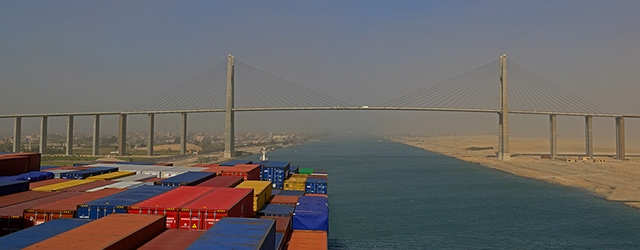A combination of structural economic reforms, oil and gas development and a recovering tourist sector fuels rapid growth for Egypt.

Egypt is likely to be the Middle East’s top economic performer this year and next, with annual GDP growth estimates near 6%. Macroeconomic stability has returned, and gas exports and tourism are growing. The Central Bank of Egypt recently eased monetary policy, which should help to keep the economy strong.
“We expect another 200 basis points of rate cuts by the end of this year,” says Jason Tuvey, a senior emerging markets economist at Capital Economics. Inflation, which had soared above 30% in mid-2017 when Egypt floated the pound, has since receded to less than 15% in recent months. Lower inflation along with a pickup in capital inflows have boosted the stock market and driven down yields on local currency bonds, he notes.
“The primary budget is back in surplus for the first time in almost two decades, and fiscal consolidation should slow substantially,” Tuvey says.
With local banks under less pressure to buy up government debt, they should be able to reorient their lending to private firms and households, he adds. This should help to boost Egypt’s low investment rate and support faster productivity gains.
The energy sector is foundational to the economy’s brightening prospects. Since 2015, when the Italian oil and gas producer Eni discovered Zohr, a supergiant gas field with 30 trillion cubic feet of reserves in Egypt’s portion of the eastern Mediterranean, the company has invested billions of dollars in the project. Another major oil and gas field came on stream in late 2017; and late last year, the Ministry of Petroleum was able to announce Egypt had attained self-sufficiency in natural gas. To attract more investors, Egypt is developing a new system for future oil and gas production contracts, whereby companies take on the costs of exploration and production in return for a share of the output, which they will not have to sell to the government at a fixed price.
Egypt is also working to develop more free-trade zones along the Suez Canal, which it hopes will spawn a manufacturing hub for exports to Europe, Tuvey says.
Bolder Measures on Hold
However, the government of Abdel Fattah El Sisi, the former general and defense minister elected president in 2014, has been wavering on introducing bolder measures Tuvey says could boost potential GDP growth by 7% or more. A state privatization program has been proceeding only slowly, and the military still holds a significant stake in the economy. For example, it owns a majority stake in the company building a new, $45 billion capital city east of Cairo. Potential investors are reluctant to invest in sectors of the economy where the military is expanding and controls the land.
Recent events suggest that’s not likely to change soon. In February, the Egyptian Parliament voted overwhelmingly in favor of constitutional amendments to extend El Sisi’s rule until 2034 and give the military a formal political role. The proposed changes must survive a public referendum; but that’s seen as likely, since little in the way of organized political opposition remains.
That said, “With the continuation of economic reforms—and as inflationary pressures have eased—we expect foreign investment to increase, while domestic businesses will be encouraged to resume borrowing,” says Hisham Ezz Al-Arab, chairman and managing director of Commercial International Bank (CIB). “As a result, there will be a positive impact on new job creation in addition to increasing banks’ loan portfolios. CIB will clearly benefit as this activity gains momentum.”

With a population of over 100 million, Egypt is the most populous Arab nation; its economy ranks among the largest in the Middle East. That makes it a tremendous market with a number of promising sectors for foreign investors. “These include infrastructure, energy, transportation and water desalination,” Al-Arab says. “In addition, the rapidly growing population is fueling the consumer goods, pharmaceutical, health care and real estate sectors.”
Underpinning these opportunities, Al-Arab says, is an economic environment conducive to investment, including an attractive cost of labor, lower distribution costs, low regulatory hurdles and improved intellectual-property protections. “In addition, Egypt is positioned as the gateway to Africa,” he says, “not only geographically, but also with the several trade agreements we have, which allow duty-free entry from many African and Arab countries. Products are, therefore, much more competitive.”
Widening Financial Inclusion
CIB aims to boost Egypt’s low level of financial inclusion by using technology. “Data analytics plays an enormous and vital role in how we make credit decisions, create new products and reach the unbanked consumer and SMEs,” Al-Arab says. “We are working hard to ensure our products and services reflect current technology enhancement and meet the demands of this younger generation of consumers.”
The bank is working with Egyptian fintechs to boost financial innovation and encourage a shift to cashless transactions. “We are supporting an innovation program at the University of Cairo and have established Digital Labs, a platform designed to bridge the gap between the financial-services sector and the emerging entrepreneurial ecosystem,” Al-Arab says.
CIB is also encouraged that the Sisi government has been addressing what the bank considers to be the country’s biggest economic challenges, notably its wobbly currency, the budget deficit, government debt levels and job creation, through a series of reforms and corrective measures. “All the reform efforts and government initiatives, such as investment in infrastructure through national megaprojects, and the easing of investment laws, have been directed to every corner of the population,” Al-Arab says.
Egypt’s reform agenda is supported by a three-year, $12 billion financial arrangement with the International Monetary Fund. IMF Managing Director Christine Lagarde, in a statement early this year, noted the government has made substantial progress; she singled out its success at achieving macroeconomic stabilization. The IMF expects Egypt to post a primary surplus target of 2% of GDP this year, for a cumulative fiscal adjustment of 5.5% of GDP over three years. Said David Lipton, the IMF’s first deputy managing director and acting chair, “The authorities remain committed to reaching cost recovery for most fuel products by the mid-2019.”
Curbing the Public Sector
The fiscal adjustments appear to be bearing fruit—or at least, not to be holding the larger economy back. Lagarde pointed to a decline in the unemployment rate to around 10%, which is the lowest since 2011, when the Arab Spring rising drove longtime leader Hosni Mubarak from power, initiating a period of instability and an expansion of social protection measures. “I would like to take this opportunity to commend the patience and commitment of the Egyptian people to the reform process,” Lagarde said. “This will pave the way for higher and more-inclusive growth for the long term.”
Lipton singled out measures “to support inclusive growth by addressing longstanding constraints to private-sector development. These include reforms to improve competition policy, public procurement, management of SOEs [state-owned enterprises] and land allocation.” Fuel prices and electricity tariffs have been hiked, and a smart card system distributes bread more efficiently, without the opportunities for graft and waste under the old system of subsidies.
“The overwhelming driver of the improvement of the budget position over the past couple of years has been a shrinking public-sector wage bill,” says Tuvey. This followed the introduction of a new civil service law in 2015 that caps the rise in public-sector base salaries at 7% a year.
Egypt’s tourism recovery, too, should help to support economic growth, says Tuvey. “Egypt’s tourism sector has mounted a rapid recovery over the past couple of years; and so long as security concerns don’t flare up again, it probably has further to run,” he predicts. “Tourism receipts could rise by a further 2% of GDP in the coming years, potentially wiping out the current account deficit.”
If tourist arrivals return to the peak recorded in 2010, which does not seem unrealistic based on the current trajectory, receipts could grow by as much as an annualized $5 billion, he adds.



